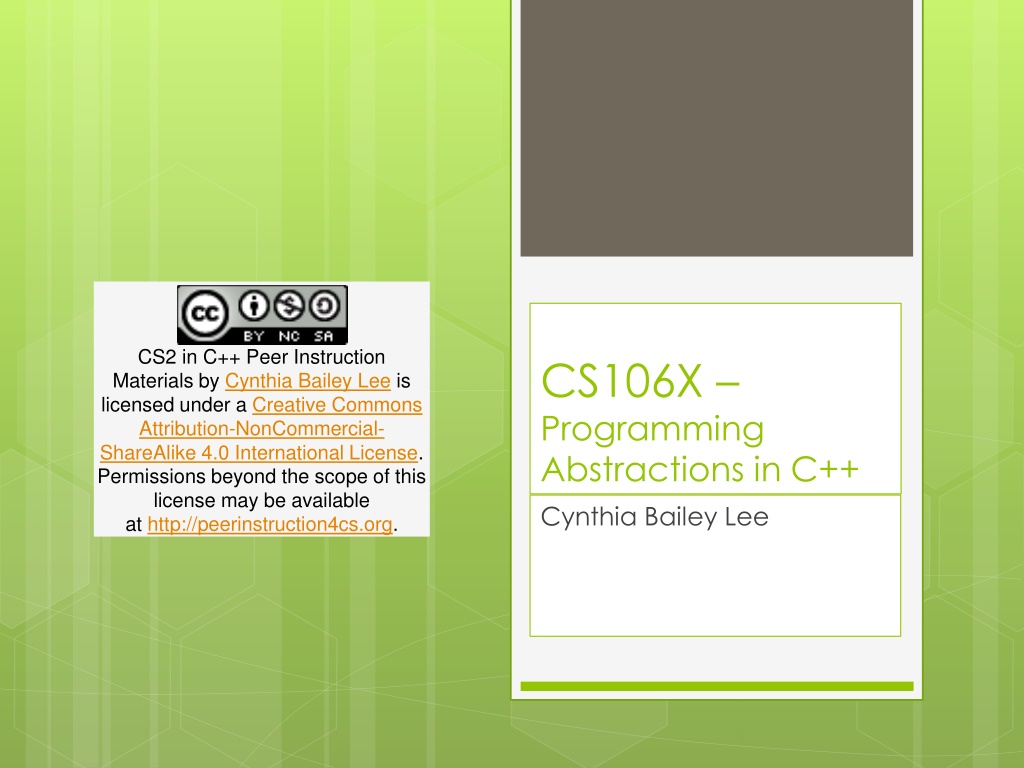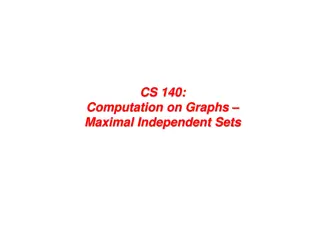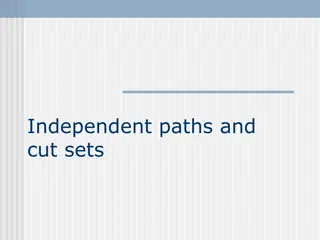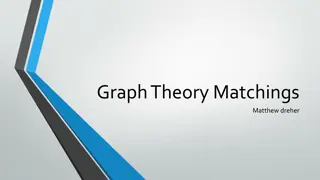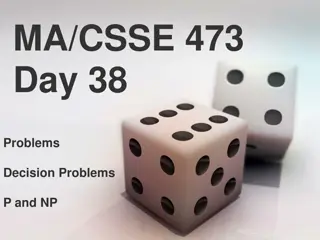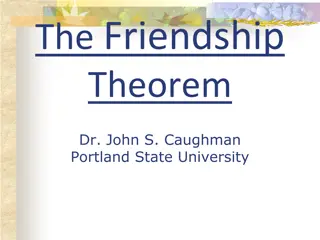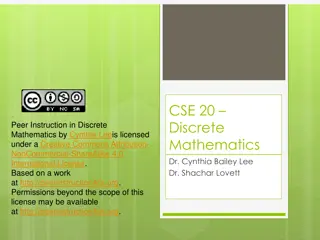Graph Theory Concepts: Clique and Independent Set in C++ Programming
Explore the concepts of cliques and independent sets in graph theory through C++ programming with Cynthia Bailey Lee's Creative Commons licensed materials. Understand NP-complete graph problems and learn about coding implementations for determining cliques and independent sets efficiently.
Download Presentation

Please find below an Image/Link to download the presentation.
The content on the website is provided AS IS for your information and personal use only. It may not be sold, licensed, or shared on other websites without obtaining consent from the author. Download presentation by click this link. If you encounter any issues during the download, it is possible that the publisher has removed the file from their server.
E N D
Presentation Transcript
Creative Commons License CS2 in C++ Peer Instruction Materials by Cynthia Bailey Lee is licensed under a Creative Commons Attribution-NonCommercial- ShareAlike 4.0 International License. Permissions beyond the scope of this license may be available at http://peerinstruction4cs.org. CS106X Programming Abstractions in C++ Cynthia Bailey Lee
2 Today s Topics 1. Deeper look at Vertex Cover and Independent Set
Clique and Independent Set Two famous NP-complete graph problems
4 Reminder: Clique and Independent Set Clique: set of vertices with all pairs having an edge Independent Set: set of vertices with no pair having an edge Which are Cliques? A B C A. { B, D, E, F } B. { B, C, D } C. { B, C } D. Other/none/more than one E D F F
5 Reminder: Clique and Independent Set Clique: set of vertices with all pairs having an edge Independent Set: set of vertices with no pair having an edge Which are Independent Sets? A B C A. { A, C, G } B. { A, C, F } C. { A, E } D. Other/none/more than one E D G F
Clique /* Returns true iff a clique of size >= k exists * in the given graph. * graph is an unweighted, undirected graph given as * an adjacency matrix. */ bool cliqueExists(Grid<bool> graph, int k); We will assume code exists for this function, and that it takes time O(X). (X is a placeholder for a mystery amount of time)
bool cliqueExists(Grid<bool> graph, int k); Independent Set // returns true iff an independent set of // size k exists in this graph bool indSetExists(Grid<bool> graph, int k) { Can we write code for indSetExists() that uses a single call to cliqueExists() as a subroutine? A. NO B. YES and it takes time (|E|), excluding the subroutine C. YES and it takes time (|V|), excl. subroutine D. YES and it takes time (|V|2), excl. subroutine E. Other/none/more than one return cliqueExists(___________________); }
bool cliqueExists(Grid<bool> graph, int k); Independent Set // returns true iff an independent set of // size k exists in this graph bool indSetExists(Grid<bool> graph, int k) { return cliqueExists(___________________); }
Time Cost To prepare for the call to cliqueExists(): O(|V|2) To run cliqueExists(): We don t know how much time that last line takes! On Monday I said O(X) that was no joke! NOBODY knows what the best we can do for X is! TOTAL:
Time Cost To prepare for the call to cliqueExists: O(|V|2) To run cliqueExists: We don t know how much time that last line takes! The slide said O(X) that was no joke! NOBODY knows what the best we can do for X is! If P=NP, then some polynomial amount of time. If N!=NP, then exponential time or worse. TOTAL: O(|V|2+X) this is polynomial if X is polynomial! IMPORTANT: we just proved that if we have a polynomial time solution to clique, then we have a polynomial time solution for independent set
Time Cost To prepare for the call to cliqueExists: O(|V|2) To run cliqueExists: We don t know how much time that last line takes! The slide said O(X) that was no joke! NOBODY knows what the best we can do for X is! If P=NP, then some polynomial amount of time. If N!=NP, then exponential time or worse. TOTAL: O(|V|2+X) this is polynomial if X is polynomial! Proof technique: REDUCTION IMPORTANT: we just proved that if we have a polynomial time solution to clique, then we have a polynomial time solution for independent set
When you buy one cliqueExists for the low, low price of polynomial time, we ll throw in an indSetExists ABSOLUTELY FREE (you pay S&H to get the indSetExists to cliqueExists) But wait, there s more! We ll look at a few more problems that can be solved by just a little code and a single subroutine call to cliqueExists()
Vertex Cover For a graph G = (V,E), a vertex cover is a set of vertices S such that: S V edges {u,v} E : u S or v S In other words, there is at least one vertex in S touching every edge in the graph
Find a vertex cover S that uses the fewest number of vertices (|S| is minimized). What is |S|? A. 1 B. 2 C. 3 D. 4 E. >4
bool cliqueExists(Grid<bool> graph, int k); Vertex Cover // returns true iff a vertex cover of size k // exists in this graph bool vertexCoverExists(Grid<bool> graph, int k) { Grid<bool> copy(graph.nRows(), graph.nCols()); for (int row=0; row<graph.nRows(); row++){ for (int col=0; col<graph.nCols(); col++){ copy[row][col] = !graph[row][col]; } } return cliqueExists(copy, graph.nRows()-k); }
bool cliqueExists(Grid<bool> graph, int k); Vertex Cover // returns true iff a vertex cover of size k // exists in this graph bool vertexCoverExists(Grid<bool> graph, int k) { return indSetExists(graph, graph.nRows()-k); } It may not be immediately obvious that the existence of an independent set of size |V|-k implies the existence of a vertex cover of size k, but if you play around with a few examples the intuition becomes clear.
Buy cliqueExists, you get two free problems* indSetExists and vertexCoverExists!! *you pay S&H But wait, there s more! How about something that doesn t even look like a graph problem?
Boolean satisfiability Proof technique: reduction by gadget
Now for something very different! In C++, as in nearly all programming languages (not to mention computer hardware), we often make chains of Boolean tests Example: if (!endCondition && (specialCase || !(row>=0)) && (row >= 0 || row < g.nRows())) To be very brief, we could write each component as a variable: if (!x0 && (x1 || !x2) && (x2 || x3))
Question: is it even possible for this to be true? You might ask yourself about a particularly complex piece of code, is there even a way to set the variables that would make this true? If not, you can just delete that code. Practice: how many of the following are possibly true? if (!x0 && x0) if (!x0 && (x1 || !x2) && (x2 || x3)) if ((!x0 || !x1) && (x0 || x2) && x1 && !x2) (A) 0 (B) 1 (C) 2 (D) 3
Reduction of CNF-SAT to cliqueExists() (!x0 && (x1 || !x2) && (x2 || x3) && x2) This has 4 clauses of OR-connected literals (a variable or its negation), and each clause is connected by AND CNF format Construct a graph as follows: Create a vertex for each literal in each clause (this example would have 6 vertices) Create edges between every vertex except: Vertices in the same clause Vertices that represent a var and its negation (x1 and !x1)
Famous NP-hard Problems Clique Independent Set Vertex Cover Set Cover Traveling salesman Sudoku Graph coloring Super Mario Brothers Subset sum http://en.wikipedia.org/wiki/List_of_NP- complete_problems
How to win ONE. MILLION. DOLLARS. //evil laugh// We showed a number of examples of this today: REDUCTIONS Find a polynomial time function for any one of these Remember, then it follows that we have a polynomial time function for all, because we can transform the others and then call the fast function PS: you will have broken all public-key encryption OR Prove that no such function exists
